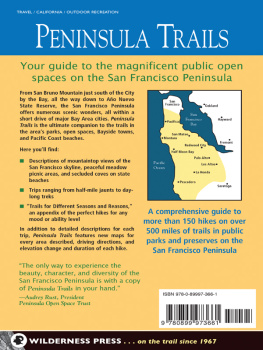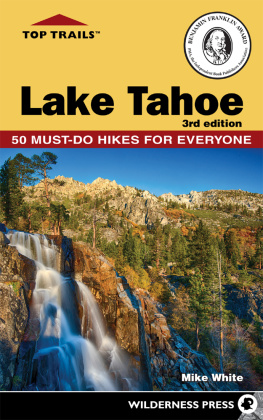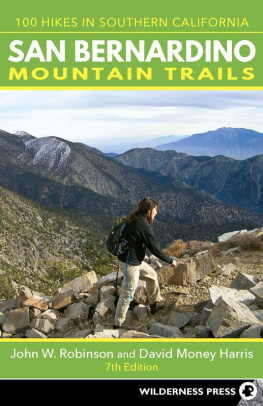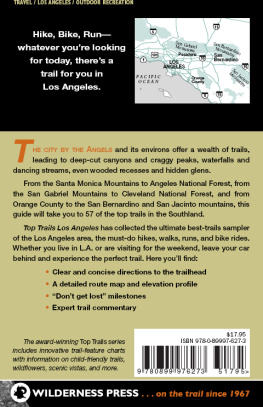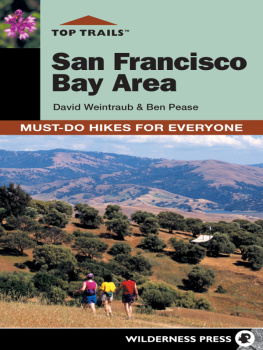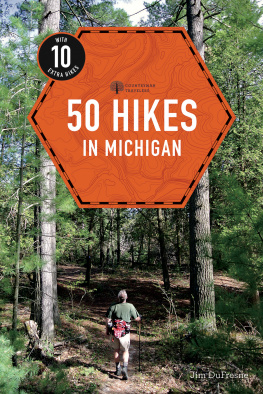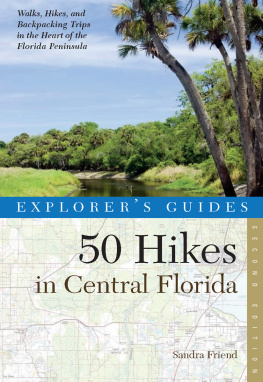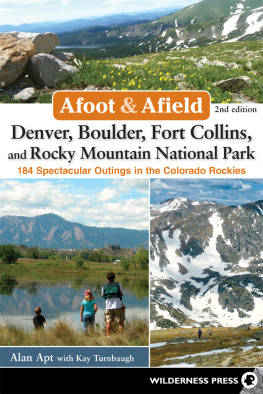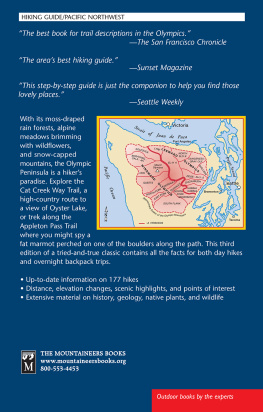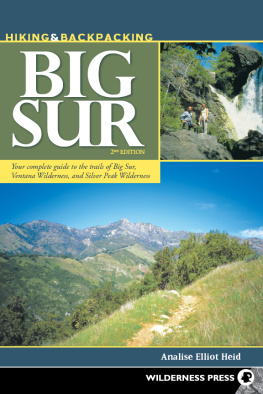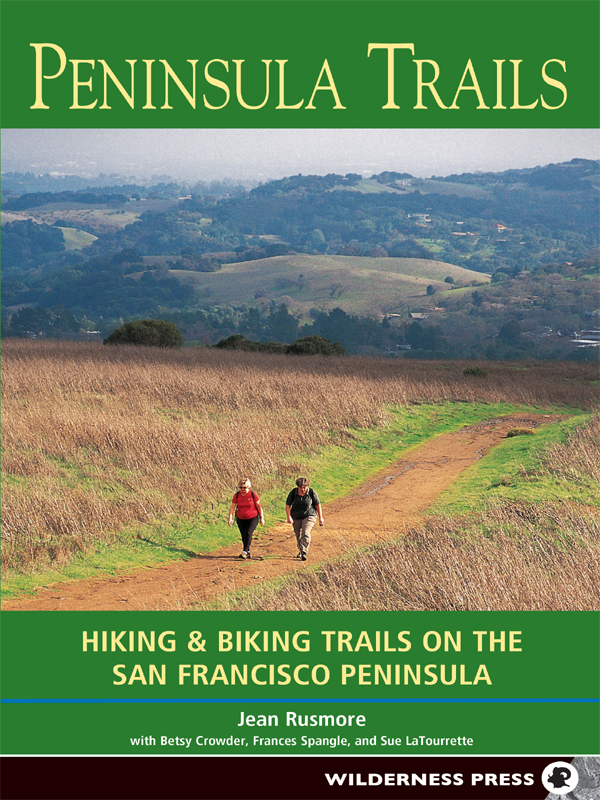

Peninsula Trails: Hiking & Biking Trails on the San Francisco Peninsula
1st EDITION January 1982
2nd EDITION January 1989
3rd EDITION May 1997
4th EDITION January 2005
2nd printing November 2007
3rd printing 2009
Copyright 2005 by Jean Rusmore, Frances Spangle, and Betsy Crowder
Front cover photo copyright 2005 by David Weintraub
Interior photos, except where noted, by Jean Rusmore
Maps: Ben Pease
Cover design: Lisa Pletka
Book design: Margaret CopelandTerragraphics
ISBN 978-0-89997-366-1
Manufactured in the United States of America
Published by: Wilderness Press
1345 8th Street
Berkeley, CA 94710
(800) 443-7227; FAX (510) 558-1696
info@wildernesspress.com
www.wildernesspress.com
Visit our website for a complete listing of our books and for ordering information.
Cover photo: The Spring Ridge Trail connects Windy Hill with Portola Valley
Frontispiece: Portola Redwoods State Park
All rights reserved. No part of this book may be reproduced in any form, or by any means electronic, mechanical, recording, or otherwise, without written permission from the publisher, except for brief quotations used in reviews.
SAFETY NOTICE: Although Wilderness Press and the author have made every attempt to ensure that the information in this book is accurate at press time, they are not responsible for any loss, damage, injury, or inconvenience that may occur to anyone while using this book. You are responsible for your own safety and health. The fact that a trail is described in this book does not mean that it will be safe for you. Be aware that trail conditions can change from day to day. Always check local conditions and know your own limitations.
Dedication
To the memory of Betsy Crowder
Acknowledgments
During the period of exploring new trails, revisiting familiar ones, and writing this fourth edition of Peninsula Trails, I have enjoyed the cooperation and help of many people. I especially thank Sue LaTourrette for accompanying me on the scouting hikes and for proofreading the text. Her sense of adventure and good humor made each trip a treat. To Peter LaTourrette for donating his bird photos and sharing his extensive knowledge of avian species, many thanks. To the many family members and friends who joined me on the trail, to Marilyn Walter, an outstanding trail advocate ready to hike and explore on short notice, to Joane and Ross Anderson who scouted several new trail routes, to my colleagues on the former San Mateo County Trails Advisory Committee, and to my delightful friends in the Walkie-Talkies womens hiking group, I extend my thanks.
The directors, rangers, and staffs of the public agencies through which these trails wind have been most helpful. In addition to their individual help, their maps, internet sites, and brochures have been indispensable. I thank all the dedicated people who plan, protect and care for the beautiful parks, preserves, watersheds, baylands, and beaches that grace the San Francisco PeninsulaGolden Gate National Recreation Area, State of California Parks and Recreation Department, California Coastal Commission, Midpeninsula Regional Open Space District, San Mateo County Parks and Recreation Department, Santa Clara County Parks Department, the Bay Area Ridge Trail, the San Francisco Bay Trail, the Juan Bautista de Anza Trail, and the many city parks and beaches. Two nonprofit organizations that secure land for future parks and open spaces deserve special mentionSempervirens Fund and the Peninsula Open Space Trust. Their longtime efforts to save magnificent redwood groves, ridgeline forests and meadows, and coastal properties continue to add lands for preservation and passive recreation on the San Francisco Peninsula.
Frances Spangle and I authored the first two editions of Peninsula Trails and South Bay Trails; when Frances moved away, Betsy Crowder joined me for the third edition. Unfortunately, an accident took her life on September 29, 2000. Sue LaTourrette joins me in dedicating this fourth edition of Peninsula Trails to Betsy.
Jean Rusmore November 2004
Table of Contents
Preface
Since the publication of the first edition of Peninsula Trails in 1982, the number of parks, preserves and open spaces and the miles of trails increased more than twofold. In the last two years Sue LaTourrette and I visited all the parks covered in the 3rd edition and hiked every new trail in each new park, preserve, beach or bayside. We marveled at the beauty and accessibility of the San Francisco Peninsulafrom the San Francisco county line to Saratoga Gap and from San Francisco Bay to the Pacific Ocean. Therein is a magnificent treasury of open space for all to enjoy. Described here are 19 open space preserves, 2 watersheds, 11 lakes, 4 Golden Gate National Recreation sites, 5 state parks, 16 county parks, 11 state beaches, and 9 Coastal Access points.
We hope this book will help you, the reader, find these open spacesthe tiny coves and broad sandy beaches along the San Mateo Coast, the miles of paved Bayside trails, the route of the Juan Bautista de Anza Trail or the Bay Area Ridge Trail, the newest park or preserve, or the summit route to one of several 2400+ peaks on the Skyline ridge. Awaiting you is the pleasure of seeing a tiny wildflower brightening the trailside in spring, the discovery of a shaded dell beside a rushing stream, a picnic lunch in a new park, and the sense of wonder when gazing at the vast Pacific from a bluff recently designated Coastal Access.
Jean Rusmore and Sue LaTourrette
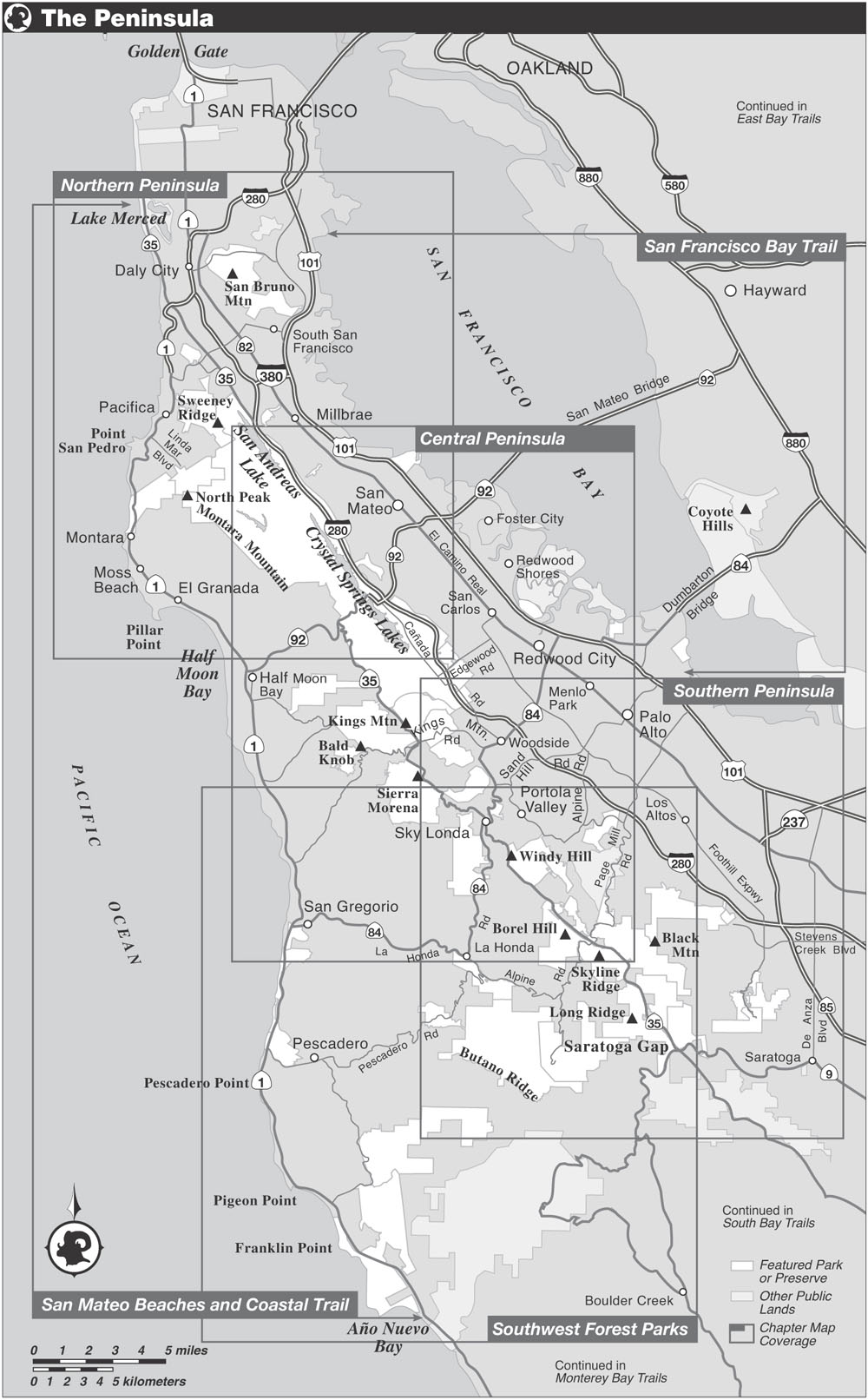
Introduction
The Peninsula Bayside, Mountain, and Coastside Setting
Geography
The Santa Cruz Mountains are part of the Coast Ranges of California. They run northwest to southeast, extending from Montara Mountain near San Francisco to Mt. Madonna near Watsonville. A natural divide splits the range into two parts at the Highway 17 pass between Los Gatos and Santa Cruz. The Spaniards called the southern section the Sierra Azul (blue mountains) and the northern part, the Sierra Morena (brown or dark mountains). The area covered by this guide centers on the Sierra Morena and includes land from the San Francisco Bay on the east to the Pacific Ocean on the west. The highest mountain in the Sierra Morena, at 2800 feet, is appropriately called Black Mountain.
The east side of the Santa Cruz Mountains, steeper than the west, is cut into deep canyons by streams that empty into San Francisco Bay. The upper reaches of these creeks, which still flow more or less untrammeled down through the mountains and the foothills, are some of the main delights of the mountainside parks. Where these creeks meandered across the Bay plain, they were once the dominant features of the landscape, bordered by huge oaks, bays, alders, and sycamores. Now they have all but disappeared from sight in the flatlands, being mostly confined to concrete ditches and culverts and bordered by chain-link fences. Two happy exceptions are the lower reaches of Los Trancos and San Francisquito creeks, which still retain their parklike tree borders as they wind through Portola Valley and the undeveloped lands of Stanford University. They are the sites of popular creekside trails.
The western slopes of the Santa Cruz Mountains are a different world from the eastern side. Very few roads cross the summit; those that do usually follow old Indian trails or Spanish routes or are remnants of former logging roads. Originally thickly forested, the canyons and ridges now support a second or third growth of redwoods and Douglas firs, interspersed with live oak, black oak, tan oak, bay laurel, and smaller shrubs and trees. Some groves of giant redwoods were spared the axe and saw. Toward the Coastside some areas formerly ranched are still open grassland.
Next page
